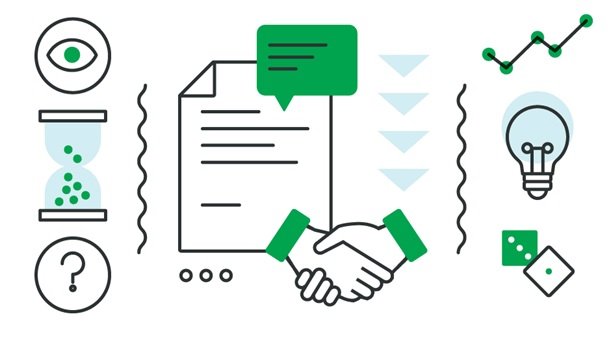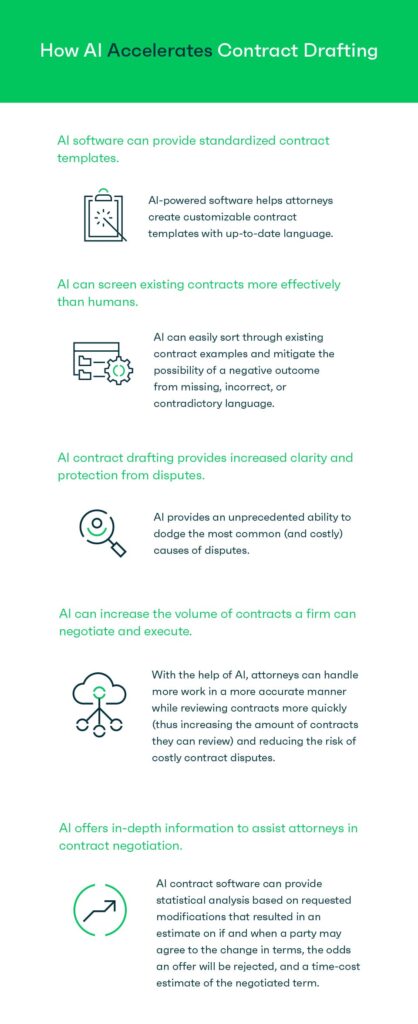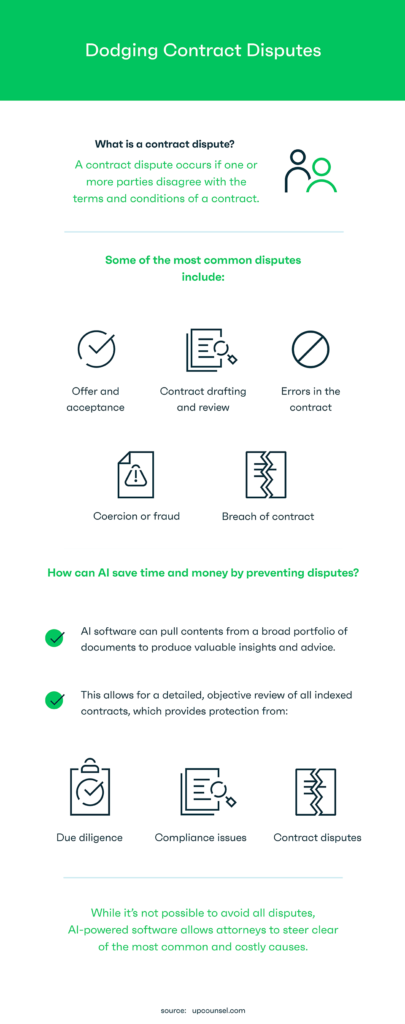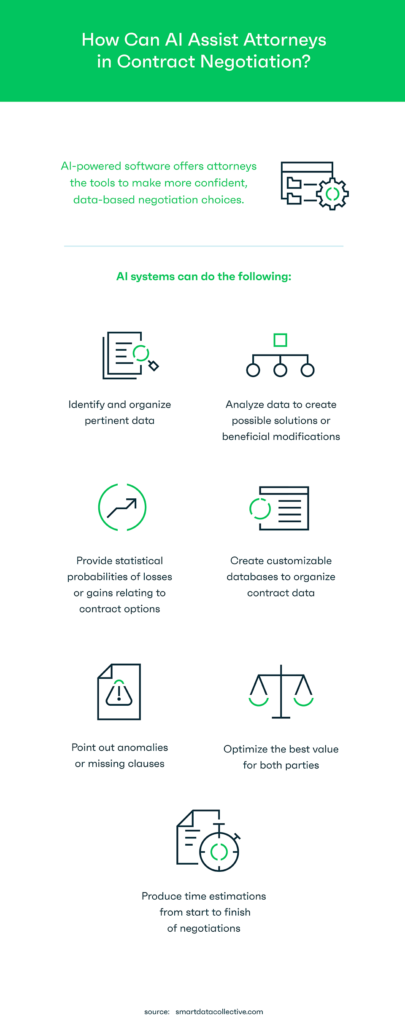How AI Accelerates the Legal Contract Drafting Process

Written by: Rachel Vanni
How AI Accelerates the Legal Contract Drafting Process
Artificial intelligence (AI) has changed how we operate in almost every facet of our lives. From digital assistants that anticipate when to order paper towels to cars that can drive themselves, AI is everywhere. Law firms can also benefit from the vast advantages AI offers. More specifically, the way in which AI changes contracts is especially impressive. Contract management, particularly drafting, can be a costly and labor-intensive process. For people dealing with large volumes of contracts, the drafting process can become a full-time job. While contract drafting software has existed for quite some time, the mechanism that drives it has changed considerably. For example, document assembly programs have been in existence since the 1990s.
These programs allow attorneys to fill in a pre-coded questionnaire that would include or exclude particular language based on responses. Once an attorney answers all the questions, the program generates a finished document. While these programs certainly assist attorneys, they have restrictions. An attorney cannot modify the coding to adapt to the particular needs of his or her clients, putting them at greater risk of malpractice.
AI closes the gaps in previous contract drafting software. It offers attorneys the tools to draft contracts, and organize and revise existing data more efficiently, and mitigates the risk of future contract disputes. Here are just a few ways AI and contracts can go hand in hand.

AI Software Can Provide Standardized Contract Templates
With every industry and within every company, specific terms, risk factors, and vital language lead to creation of specific contract templates. Many businesses create their own templates based on years of experience, trial and error, and past legal disputes. However, the shaping of new, applicable templates can take a lot of time and effort.
AI contract drafting is completed by providing the software with the ability to learn from past or similar contracts. The AI-powered software scans previous documents—identifying important terms and analyzing changes—and can draft a pertinent legal contract template in seconds. The attorney can review the drafted contract, make changes, and then resubmit it to the AI software to learn which language qualifies as acceptable and what changes should be made. Any subsequent contracts will be adapted and improved based on the recommended modifications entered by the attorney. Users can teach their AI about new recommended provisions, allowing every attorney to create customized templates for their practice.
One of the most challenging facets of legal practice is that it continually changes. Every day the precedent expands, with thousands of opinions published nationally. All attorneys have an ethical duty to stay informed and on top of any new developments that may impact their clients. AI-created contract templates will always provide up-to-date language, a serious concern for attorneys in rapidly changing practice areas. AI can identify any existing contracts and modify them quickly to remain compliant, preventing a potential source of malpractice. Lawyers can draft contracts with the peace of mind that their templates will never contain outdated language.
AI-powered contract templates can be applied to a wide variety of industries but are especially useful for users who deal with large volumes of contracts that require frequent modifications. For example, let’s say an attorney works as in-house counsel for a business that imports goods regularly from China. The companies exchange contracts on a daily basis for a variety of products that are modified only slightly from shipment to shipment. The price of these particular goods may fluctuate due to the cost of materials agreed upon in the original contract. AI can automatically adapt and change each template to fit the requested goods, modifying the cost up to a prescribed amount. Thanks to AI, companies can easily adhere to any changes in international sales law, and attorneys will be alerted to updates in trade policy. Because the contract templates can be automatically adapted, the attorney will save hundreds of hours in contract drafting each year.
AI Can Screen Existing Contracts More Effectively Than Humans
The ability to draft new contracts is invaluable, but what about existing contracts up for renewal or modification? AI-powered software can screen existing contracts and pull valuable data with remarkable accuracy. As seasoned attorneys know, the devil is in the details. Missing, incorrect, or contradictory language can make or break an agreement. AI can easily sort through existing contract examples and mitigate the possibility of a negative outcome. Even a simple typo can cause catastrophic effects. To demonstrate, let’s look at a common example. Company A contracts with a manufacturer for the delivery of goods to be delivered by the end of the current year. The attorney for Company A mistakenly types “December 31, 2021,” instead of “December 31, 2020.” The manufacturer delays the creation of the goods under a belief that the company misspoke during negotiations. This causes the launch of Company’s A product to be delayed, losing customer momentum and investor interest. Had Company A used AI, they may have caught the error, given that all prior contracts had been completed within one year.
Aside from catching errors, AI can complete these tasks faster and more accurately than humans. That said, AI can’t replace the judgement, empathy, reasoning, and creation of complex legal strategies that human attorneys possess. It can, however, complement the work of attorneys, and free up valuable time to focus on higher level work. AI can sift through thousands of contracts in mere seconds, cutting laborious hours for attorneys and reducing excessive fees for clients. Kira Systems founder, Noah Waisberg, noticed how junior corporate lawyers spent hundreds of hours doing work that should have taken just a fraction of the time. With Kira’s software, lawyers can save significant time. For instance, global ride-sharing company Integreon reduced overall contract review time by 40 percent with Kira.
AI Contract Drafting Provides Increased Clarity and Protection from Disputes
AI breaks down written contracts into readable, easily accessible data that can be analyzed and manipulated in endless ways. AI looks at contracts at a deeper level, associating each term as part of a whole, not unlike a mathematical equation. With a logical foundation, it can pull contents from a broad portfolio of documents to produce valuable insights and advice. This allows for a detailed, objective review of all indexed contracts, providing unparalleled protection from due diligence, compliance issues, and contract disputes.
Contract disputes often arise due to a misunderstanding, errors or omissions, or a failure to clearly state the duties of each party. While you can’t avoid all disputes, AI provides an unprecedented ability to dodge the most common (and costly) causes. Contract disputes account for trillions of dollars globally each year, putting a heavy burden on businesses, our legal system, and our economy. AI can drastically cut dispute costs by bringing inaccurate or unclear terms to the attention of attorneys before they result as the basis of litigation.
For example, Company A creates an agreement for the exchange of goods with Company B. Company A’s attorney drafts a contract detailing the time and manner of the delivery of goods, including a termination clause that is contradicted in existing mandatory authority. Company A then uses AI-software to review all pending contracts. The AI alerts Company A to this contradiction and provides alternative terms that are in line with the current law. This prevents a costly contract dispute with Company B, allowing both businesses to continue their relationship without delay or conflict.

AI Can Increase the Volume of Contracts a Firm Can Negotiate and Execute
One of the biggest challenges that firms face today is the overwhelming number of contracts involved in representing clients, particularly commercial businesses. Ineffective contracting can severely impact the profitability of businesses. Firms can lose up to 40 percent of value by not approaching contract creation, negotiation, or execution efficiently. The job of creating, editing, and updating contracts is repetitive, tedious, and perfectly tasked for AI-powered software. With the help of AI, attorneys can handle more work in a more accurate manner while reviewing contracts more quickly (thus increasing the number of contracts they can review) and reducing the risk of costly contract disputes.
In essence, AI complements the work of attorneys by picking up the slack, providing assistance in data-driven tasks, and leaving context and detailed legal analysis to humans. This is especially good news for mid-sized or boutique law firms who don’t have staff members to spare. AI is designed to handle large volumes of tedious work at a lightning-fast pace, allowing attorneys to pick up where it left off.

AI Offers In-Depth Information to Assist Attorneys in Contract Negotiation
AI technology isn’t limited to document processing; it can also provide attorneys with more in-depth insight to assist during negotiation. It has the ability to process all data relating to a negotiated contract, including past terms that led to a positive result. AI contract software can also provide statistical analysis based on requested modifications that resulted in an estimate on if and when a party may agree to the change in terms, the odds an offer will be rejected, and a time-cost estimate of the negotiated term. This type of business insight is invaluable, especially when the contracting process is time sensitive or company margins are already thin.
For example, an attorney represents Company A, a shipping company that transports goods within their home state. Company A is successful and wants to expand nationally but is concerned about the exponential increase in client contracts they will need to manage. Using AI software, Company A can draft, negotiate, and execute contracts in record time while relying on their existing legal team. They are now free to grow as they desire, without the burden of excessive legal fees.
Conclusion
Business is all about building partnerships with others, evidenced by agreements made to reflect promises and expectations of that relationship. Efficient contract drafting is the foundation for healthy and functional business partnerships. AI provides an unparalleled ability for lawyers to negotiate effectively, predict potential pitfalls, and avoid disputes. It isn’t far-fetched to think of a future where there is an ethical obligation for attorneys to use all tools at their disposal, including AI-contract drafting software. In fact, it may eventually be considered legal malpractice to not use AI.
Resources:
https://scholarship.law.duke.edu/cgi/viewcontent.cgi?article=1306&context=dltr
https://www.lexology.com/blog/2019/07/how-your-legal-department-can-benefit-from-ai-
contract-management
https://www.nanalyze.com/2019/03/artificial-intelligence-legal-contracts/




